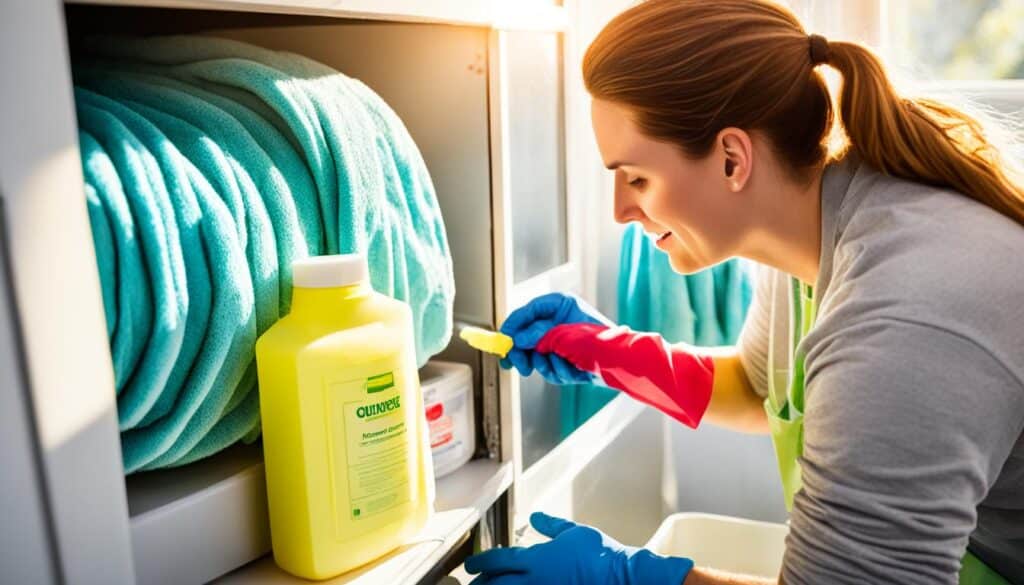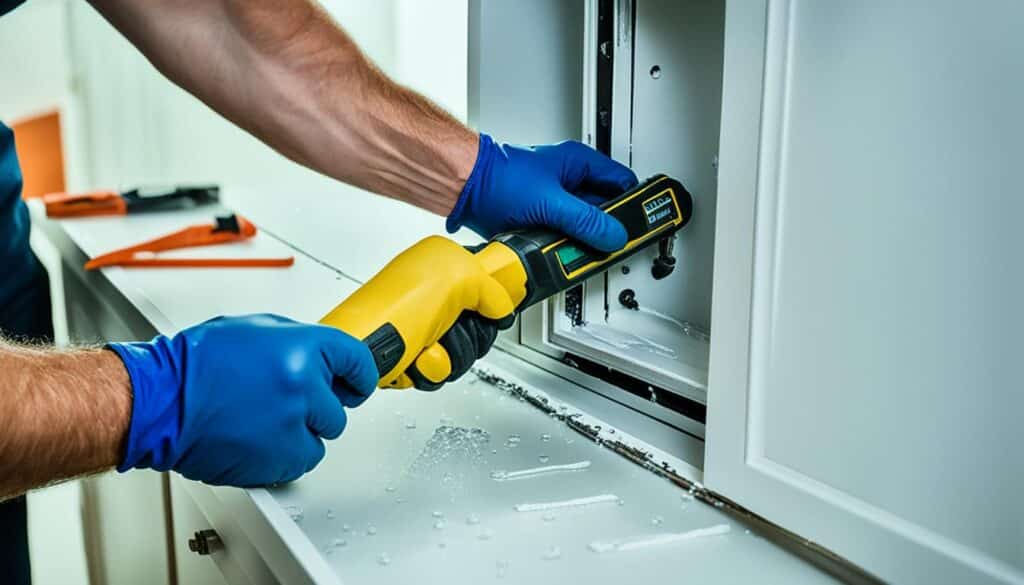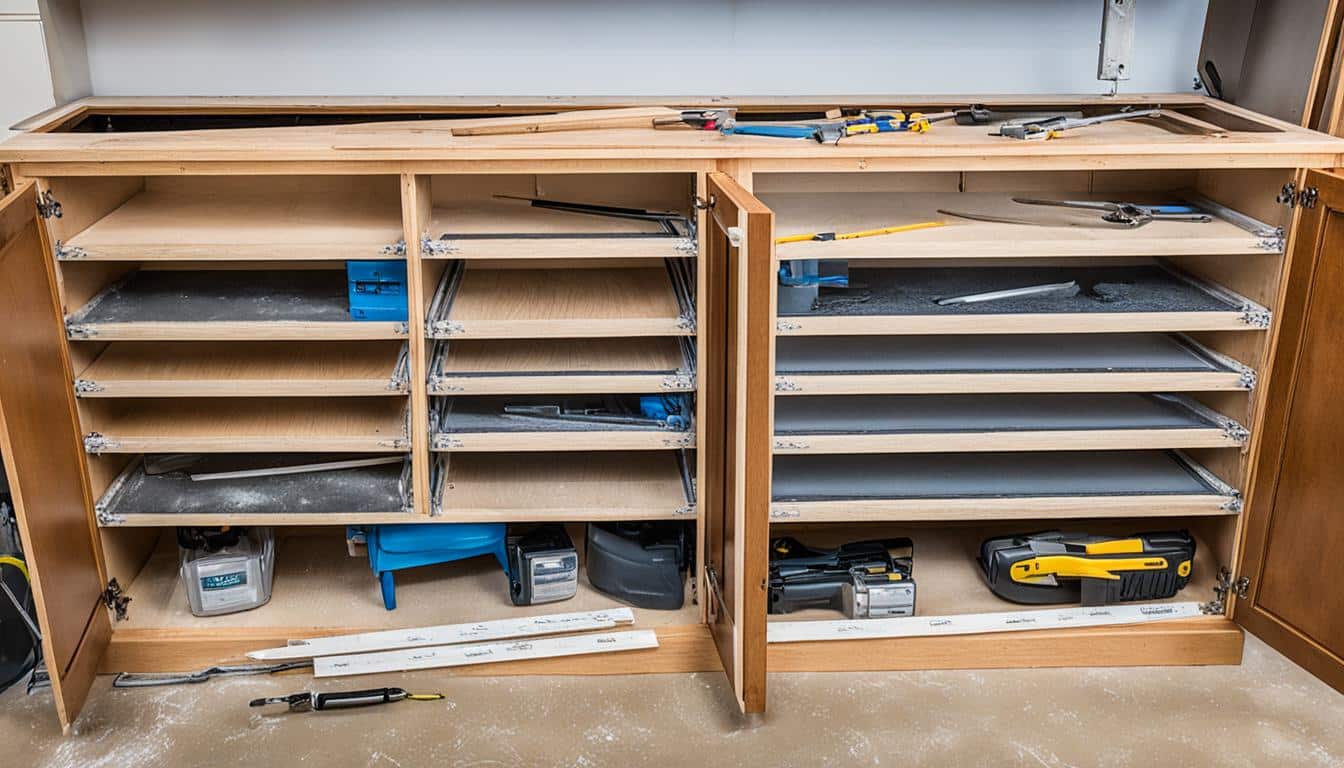Did you know that water damage is one of the most common issues homeowners face with their cabinets?
Whether it’s a leaky pipe, a kitchen mishap, or a natural disaster, water damage can wreak havoc on your cabinets, leaving them looking dull, warped, and unsightly.
The good news is that you don’t have to live with damaged cabinets or spend a fortune on replacements.
With the right know-how and a little DIY effort, you can restore the beauty of your water damaged cabinets and breathe new life into your kitchen.
In this article, I will guide you through the step-by-step process of fixing water damaged cabinets.
From cleaning and prep to repairing and restoring, I’ll share valuable insights and expert tips to help you transform your damaged cabinets into stunning focal points once again.
So, if you’re ready to roll up your sleeves and embark on a cabinet restoration journey, let’s dive right in and learn how to bring back the beauty of your water damaged cabinets!
Steps to Clean and Prep Water Damaged Cabinets
When dealing with water damaged cabinets, it is important to follow a series of steps to effectively clean and prep them for repair.
This process involves addressing the water or chemicals used to extinguish the fire, drying the cabinets to prevent mold growth, and thoroughly cleaning the surfaces to remove oils and grime.
To begin, assess the extent of the damage and identify the source of the water.
This will help determine the necessary actions to take to restore the cabinets. It is crucial to ensure the structural soundness of the cabinets before proceeding with any repairs.
Start by removing any standing water or moisture from the cabinets. Use towels or a wet/dry vacuum to absorb as much water as possible. Pay extra attention to the corners and crevices where water tends to accumulate.

Next, allow the cabinets to thoroughly dry. This step is crucial to prevent the growth of mold and mildew. Open windows or use fans to promote air circulation and expedite the drying process.
It may take several hours or even a few days for the cabinets to completely dry, depending on the extent of the water damage.
Once the cabinets are dry, it’s time to clean the surfaces. Use a mild detergent or a water and vinegar solution to remove any dirt, grime, or residue left behind by the water.
Scrub gently with a soft cloth or sponge, paying attention to hard-to-reach areas.
If mold is present on the cabinets, it is essential to address it promptly. Mold can pose health risks and further damage the cabinets.
Use a mold removal solution or a mixture of bleach and water to kill and remove any mold. Make sure to wear protective gloves and a mask when working with mold or cleaning solutions.
Finally, once the cabinets are clean and free from mold, allow them to dry completely before proceeding with any repairs or restoration work.
By following these steps to clean and prep your water damaged cabinets, you will be well on your way to restoring their beauty and functionality.
Remember, if you are unsure about the extent of the damage or lack the necessary tools and expertise, it is always best to consult a professional.
Repairing Water Damaged Cabinets
After cleaning and evaluating the cabinets, the next step is to repair the water damage.
This crucial step ensures that your cabinets regain their functionality and aesthetics. Depending on the extent of the damage, you may need to consider different repair options.
Replacing Damaged Cabinet Doors
If the water damage has severely affected the cabinet doors, it may be necessary to replace them. This involves carefully removing the damaged door and installing a new one.
By selecting a door that matches the style and finish of your existing cabinets, you can seamlessly restore the overall look of your kitchen or bathroom.

Cabinet Refacing
In cases where the water damage is less severe, cabinet refacing offers a cost-effective solution.
This process involves applying a new veneer over the existing cabinet surfaces and replacing the hinges, handles, and drawer fronts.
Cabinet refacing can provide a fresh, updated look without the need for a full replacement.
Structural Restoration of Cabinets
In instances where the water damage has compromised the structural integrity of the cabinets, a more comprehensive restoration approach may be required.
This can involve disassembling and rebuilding the cabinets to ensure their stability and functionality. Additionally, matching the stain color of the damaged areas can help maintain a cohesive appearance throughout the cabinetry.
By addressing the specific needs of your water damaged cabinets, whether it’s replacing a door, refacing the surfaces, or restoring their structure, you can effectively revive their beauty and prolong their lifespan.
Cost and Timeline of Cabinet Restoration
The cost and timeline of cabinet restoration can vary depending on several factors.
These factors include the number of cabinets that need restoration, their style, the size of the kitchen, the type of wood and finish used, and the extent of the damage.
It is important to consider these factors before starting the restoration work.
Before moving forward with the restoration project, it is advisable to get a cost estimate from a professional or calculate the estimated expenses yourself.
This will help you plan your budget accordingly and ensure that you are prepared for the cost of cabinet restoration.
The timeline for cabinet restoration can also vary based on the specific requirements of the project. For simple cleaning and touch-up, the process typically takes one to two days.
If you are looking to change the color of the cabinets, it may take between three to five days. More extensive restoration work, such as structural repairs or cabinet refacing, can take a few weeks to complete.
One of the significant advantages of cabinet restoration is its environmental impact. By choosing restoration over replacement, you can contribute to reducing waste.
Additionally, many restoration processes can be done using water-based products, which are more eco-friendly than traditional solvent-based alternatives.
FAQ
How Can I Fix Water Damaged Cabinets Myself?
To fix water damaged cabinets yourself, start by cleaning and prepping the cabinets, addressing any water or chemical residue, and drying the cabinets thoroughly.
Then, evaluate and repair any structural damage, which may involve replacing cabinet doors, refacing the cabinets, or matching stain colors.
Finally, restore the cabinets’ finish and consider using environmentally responsible, water-based products.
What Steps Are Involved In Cleaning And Prepping Water Damaged Cabinets?
Cleaning and prepping water damaged cabinets involves addressing any water or chemical residue, drying the cabinets to prevent mold growth, and cleaning oils and grime from the surfaces.
Special products and tools such as HEPA vacuums may be necessary for effective cleaning. It is essential to evaluate the structural soundness and identify the source of the damage before proceeding.
How Do I Repair Water Damaged Cabinets?
Repairing water damaged cabinets can involve replacing the damaged cabinet door with a new one or refacing the cabinets by applying a new veneer over the existing surfaces and replacing hinges, handles, and drawer fronts.
Structural restoration may also be necessary, which can include disassembling and rebuilding the cabinets or matching the stain color of damaged areas.
The repair process varies depending on the severity of the damage and the specific needs of the cabinets.
How Much Does Cabinet Restoration Cost And How Long Does It Take?
The cost and timeline of cabinet restoration depend on various factors such as the number of cabinets, style, kitchen size, type of wood and finish, and the extent of the damage.
Before starting the process, it’s important to get a cost estimate from a professional or calculate expenses yourself.
The timeline for cabinet restoration can range from one to two days for cleaning and touch-up, three to five days for changing the color, and a few weeks for structural restoration or cabinet refacing.
Cabinet restoration is an environmentally responsible alternative to replacement, reducing waste and can be done using water-based products.

